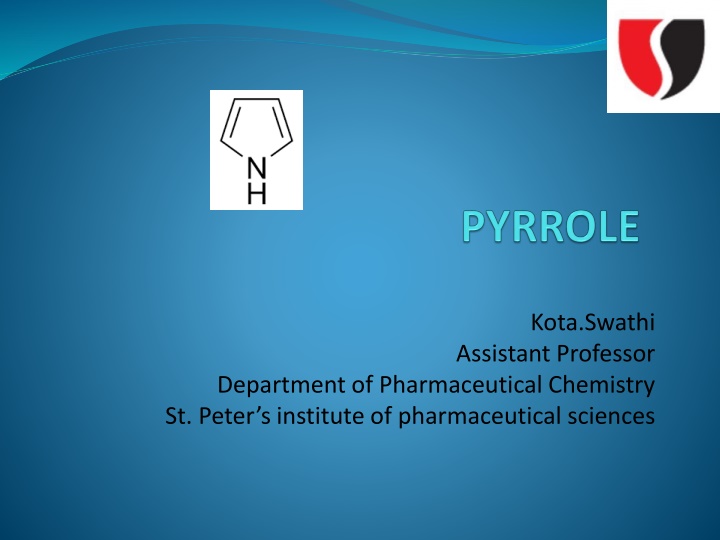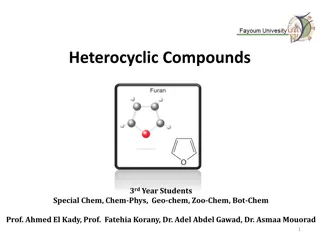
Pyrrole: Synthesis, Reactions, and Medicinal Uses
"Explore the synthesis methods of pyrrole, its electrophilic substitution reactions, acetylation, oxidation, reduction, and various medicinal uses. Pyrrole is a crucial heterocyclic compound found in natural substances like alkaloids, haemoglobin, and chlorophyll. Discover how pyrrole plays a significant role in pharmaceutical chemistry and its diverse applications in medicine." (296 characters)
Download Presentation

Please find below an Image/Link to download the presentation.
The content on the website is provided AS IS for your information and personal use only. It may not be sold, licensed, or shared on other websites without obtaining consent from the author. If you encounter any issues during the download, it is possible that the publisher has removed the file from their server.
You are allowed to download the files provided on this website for personal or commercial use, subject to the condition that they are used lawfully. All files are the property of their respective owners.
The content on the website is provided AS IS for your information and personal use only. It may not be sold, licensed, or shared on other websites without obtaining consent from the author.
E N D
Presentation Transcript
Kota.Swathi Assistant Professor Department of Pharmaceutical Chemistry St. Peter s institute of pharmaceutical sciences
Pyrrole is an unsaturated five membered heterocyclic compound with nitrogen as heteroatom at 1stposition. It is a word derived from Greek, which pyrros means fiery oil. Molecular fomula: C H N. One of the important heterocyclic compound because many naturally occuring compounds contain pyrrole ring. E.g: Alkaloids, haemoglobin, chlorophyll . It produces a bright red color when brought in contact with a pine splint moistened with conc. HCl. Source: Occurs in bone oil, coal tar & also derived from proteins. Obtained from dry distillation or pyrrolysis of animal byproducts such as horns, hooves & bones.
Synthesis 1. FROM BONE OIL Bone oil dil. Alkali bone oil free from acidic impurities dil.acid bone oil free from basic impurities fractional distillation Pyrrole ring fraction obtained (373K-423K) fused with KOH Potassium salt of Pyrrole steam distillation Pure Pyrrole (C H N) 2. FROM ACETYLENE (COMMERCIAL METHOD): Pyrrole can be synthesized commercially by passing a mixture of acetylene & ammonia through a red hot tube. HC CH + HC CH NH
3. FROM SUCCINIMIDE: when succinimide is distilled with Zn dust, it reduced to pyrrole. 4. FROM FURAN: Furan on heating with ammonia in the presence of alumina (Al O ) gives pyrrole over 400 C. 5. PAAL-KNORR SYNTHESIS: By heating 1,4-dicarbonyl compounds with ammonia / primary amines/ hydrazines to give pyrrole derivatives is known as paal knorr synthesis.
Electrophilic Substitution Reactions Pyrrole undergoes substitution reaction predominantly at C providing thermodynamically stable product. Although substitution also occurs at C in some kinetically controlled reactions.
Acetylation: Pyrrole treated with acetic anhydride at 200C gives 2-acetyl pyrrole while N-acetyl pyrrole cane be obtained by heating with N-acetyl imidazole. Oxidation & Reduction: Pyrrole oxidized to maleinimide by chromium trioxide (CrO ) in presence of acetic acid where as it catalytically reduced completely hydrogenate the ring system & produce pyrrolidine.
THANK YOU THANK YOU


